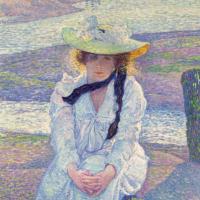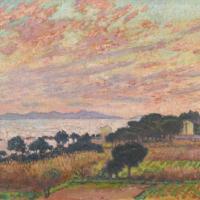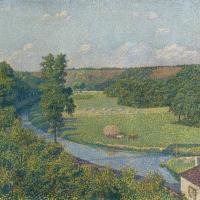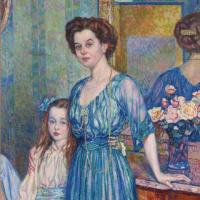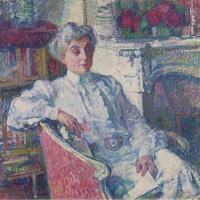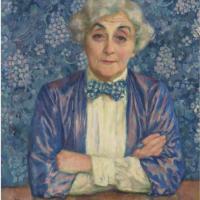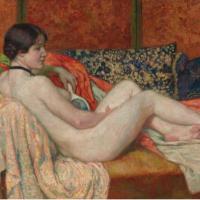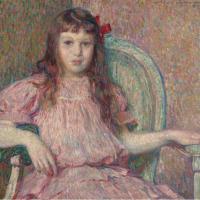Theo Van Rysselberghe
Theo Van Rysselberghe
Theo Van Rysselberghe (1862-1926)
Théo Van Rysselberghe , born in Ghent on November 23 , 1862, and died in Saint-Clair in Le Lavandou ( Var ) on December 13 , 1926, is a Belgian painter , known to have been one of the main representatives of divisionism in Belgium.
Acquired with anarchist ideas , close friend of Élisée Reclus and Paul Signac , he gives drawings to the libertarian press including The New Times of Jean Grave from 1897 to 1911.
Theo Van Rysselberghe, of the Van Rysselberghe family , is the brother of Charles Van Rysselberghe and Octave Van Rysselberghe , both architects. He married Maria Monnom in 1889. They have a daughter, Elisabeth (born in 1890), who will be the mother of Catherine , the only child of André Gide .
After studying at the Ghent Academy of Fine Arts and at the Brussels Academy under the direction of Jean-François Portaels , Théo Van Rysselberghe participated in an exhibition at the Brussels Salon for the first time in 1881 . Around 1886 - 1887, he discovered the work of Georges Seurat with Émile Verhaeren . Friend of Octave Maus , it is a founding member in 1883 of the group in Brussels for pioneering the Twenty . At the end of the xix th century , the pointillism of his paintings gave way to a broad composition elongated keys. Like Georges Seurat and Paul Signac , he created many seascapes. He also made engravings that are less known.
The following year, he traveled (following in the footsteps of Jean-François Portaels) in Spain and Morocco with his friend Frantz Charlet and the Asturian painter Dario de Regoyos . He particularly admired the "old masters" at the Prado Museum . In Seville , they meet Constantine Meunier , and his son Charles, known as Karl, who painted a copy of Pedro de Campaña's Descent from the Cross . From this trip to Spain, he brings back the following portraits: Spanish Woman ( 1881 ) and La Sevillane ( 1882 ). There are four months left in Tangier to practice drawing and painting picturesque scenes of the street, the Kasbah and the souks : shoemaker of the Arab street ( 1882 ), Arab boy ( 1882 ), Rest of guard ( 1883 ) .
He will return there twice, in 1883 - 1884 then in 1887 - 1888 .
Back in Belgium, he shows about thirty works of his trip to the Cercle Artistique Littéraire and Ghent. They meet an instant success, in particular The smokers of kif , The seller of oranges and a Seascape seascape (setting sun) , Tangier ( 1882 ). In April 1883 , he exhibited these scenes of Mediterranean daily life at the Essor show in Brussels in front of an enthusiastic public. It was also at this time that he made friends with the writer and poet Émile Verhaeren , whom he would later represent several times. In September 1883 , Van Rysselberghe went to Haarlem to study light in the works of Frans Hals . The precise rendering of the light will continue to occupy his mind. There, he also met the American painter William Merritt Chase . He painted his first pointillist works on the model of Georges Seurat . He was then part of the group La Libre Esthétique for which he executed a poster (1896).
His friendship with Paul Signac also deals with anarchist ideas . He participated in the press libertarian including regularly to the newspaper The New Times of Jean Grave , to whom he gives the works from 1897 to 1911. He attended the geographer Elisee Reclus and the painter Camille Pissarro . In 1899, he made the cover of The Anarchist Morality of Peter Kropotkin .
In the late 1890s , he settled in Provence in Saint-Clair near Lavandou and returned to a certain form of classicism .
His daughter Elizabeth, after having a daughter, Catherine , with André Gide , married in 1931 the novelist of Dunkirk Pierre Herbart.
He paints many portraits that he dedicates mainly to his relatives, including that of Alice Sète . The latter enhances the decor, painted with precision, which contrasts with the synthetic will of French pointillists . His characters do not have the "hieraticism" of those of Seurat as Emile Verhaeren points out .
In addition to post-impressionism , the painter will also be influenced by the Japanese , admirer, especially Hiroshige . His maritime landscapes are simplified, contrasting with the luxury of details of his portraits .
He painted a number of groups of female nudes which he made his favorite theme from 1910 : The Hour burned ( 1897 ), Bather around a rock ( 1910 ), Bather Cavalière ( 1910 ). He also paints some isolated nudes ( Swimmer at rest : 1922 , Ablution or Venus squatting : 1922 ). Eroticism, however, does not seem very present, at least for the writer André Gide, who speaks about "hygienic nudes" . This period sees the transition from the post-impressionist influence to a trend towards classicism.
Théo van Rysselberghe also illustrated books, such as Émile Verhaeren's collection of texts , the Almanac in 1895 , drawing initials, arabesques and illustrations. He thus decorates some catalogs of exhibition of the group of XX .


